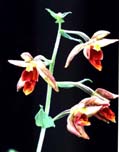|
Epipactis,
Eriochilus, Eulophia, Goodyera, Gymnadenia,
Habenaria, Herschelianthe, Neottianthe |
 |
Coloured signs |
Size of plants |
|
Epipactis |
|||
| mairei | dark red flowers | Cc | F 25,- |
| gigantea | common type | Do | 1y 4- |
| gigantea 'Serpentine Night' | leaves red flushed | Do | 1y 5,- |
| gigantea x royleyana | new hybrid | Do | 1y 5,- |
| gigantea x Limodorum abortivum | let us see | Do | 1y 15,- |
| palustris | common type | Do | 1y 3,- |
| palustris x mairei | fast multiplication type | Do | F 30,- |
| palustris x veratifolia | palustris is motherplant in contrast to 'Sabine' | Do | 1y 5,- |
| royleyana | pretty flowers | Do | 2y 18,- |
| royleyana x Cephalanthera rubra | new interesting hybrid | Do | 1y 15,- |
| thunbergii | beautiful multicolour flowers | Cc | F 25,- |
| veratifolia x palustris | large white and red flowers | Do | 1y 3,- |
| veratifolia x mairei | large colourful flowers | Do | 3y 30,- |
|
Eriochilus |
|||
| cucullatus | white and red flowers, remembering to Caladenia | Th | F 18,- |
|
Eulophia |
|||
| meleagris | blueish flowers | Ee | 2y 10,- |
|
Goodyera |
|||
| biflora var. macrantha | very large white and pink flowers ( 4cm sepals ) | G | F 20,- |
| foliosa | G | F 15,- | |
|
Gymnadenia |
|||
| orchidis | O | F 20,- | |
|
Habenaria |
|||
| balfouriana | fyellow flowers | He | F 25,- |
| longidenticulata | medium sized flowers, showy finged lip | He | F 25,- |
| davidii | great white flowers, showy fringed lip | O | F 30,- |
|
Hemipilia |
|||
| quinquangularis | flowers like Orchis, 2 spotted leaves | He | F 35,- |
| erucuita | flowers like Orchis, 2 spotted leaves | He | F 35,- |
|
Herschelianthe |
|||
| lugens | unique flowers | H | 1y 15,- |
|
Megastylis |
|||
| sp. |
very large orchids |
O |
1y 5,- |
|
Neottianthe |
|||
| pseudodiphylax | Pe | F 28,- | |
| Next Page |
Himantoglossum |
||||
|
E: ( Epipactis palustris, gigantea, veratifolia and hybrids
) Ee: ( Eulophia ) G: ( Goodyera) H: ( Herschelianthe ) Th: ( Thelymitra, Diuris ) Pe : ( Aminostigma, Poenorchis, Hemipilia ) |